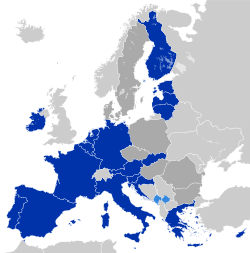| Roadmap [17] | Action plan [17] | Status as of June 2015 |
|---|
Stage 1: Ensuring fiscal sustainability and breaking the costly link between banks and sovereigns
(2012–13) | Framework for fiscal governance shall be completed through implementation of: Six-Pack, Fiscal Compact, and Two-Pack. | Point fully achieved through entry into force of the Six‑Pack in December 2011, Fiscal Compact in January 2013 and Two‑Pack in May 2013. |
|---|
| Establish a framework for systematic Ex Ante Coordination of major economic policy reforms (as per Article 11 of the Treaty on Stability, Coordination and Governance). | A pilot project was conducted in June 2014, which recommended the design of the yet to be developed Ex Ante Coordination (EAC) framework, should be complementary to the instruments already in use as part of the European Semester, and should be based on the principle of "voluntary participation and non-binding outcome". Meaning the end result of an EAC should not be a final dictate, but instead just an early delivered politically approved non-binding "advisory note" put forward to the national parliament, which then can be taken into consideration, as part of their process on improving and finalizing the design of their major economic reform in the making. [18] |
| Establish European Banking Supervision as a first element of the Banking union of the European Union, and ensure the proposed Capital Requirements Directive and Regulation (CRD‑IV/CRR) will enter into force. | This point was fully achieved, when CRD‑IV/CRR entered into force in July 2013 and European Banking Supervision became operational in November 2014. |
| Agreement on the harmonisation of national resolution and deposit guarantee frameworks, so that the financial industry across all countries contribute appropriately under the same set of rules. | This point has now been fully achieved, through the Bank Recovery and Resolution Directive (BRRD; Directive 2014/59/EU of 15 May 2014) which established a common harmonized framework for the recovery and resolution of credit institutions and investment firms found to be in danger of failing, and through the Deposit Guarantee Scheme Directive (DGSD; Directive 2014/49/EU of 16 April 2014) which regulates deposit insurance in case of a bank's inability to pay its debts. |
| Establish a new operational framework under the auspice of the European Stability Mechanism (ESM), for conducting "direct bank recapitalization" between the ESM rescue fund and a country-specific systemic bank in critical need, so that the general government of the country in which the beneficiary is situated won't be involved as a guaranteeing debtor on behalf of the bank. This proposed new instrument, would be contrary to the first framework made available by ESM for "bank recapitalizations" (utilized by Spain in 2012–13), which required the general government to step in as a guaranteeing debtor on behalf of its beneficiary banks – with the adverse impact of burdening their gross debt-to-GDP ratio. | ESM made the proposed "direct bank recapitalization" framework operational starting from December 2014, as a new novel ultimate backstop instrument for systemic banks in their recovery/resolution phase, if such banks will be found in need to receive additional recapitalization funds after conducted bail-in by private creditors and regulated payment by the Single Resolution Fund. [19] |
Stage 2: Completing the integrated financial framework and promoting sound structural policies
(2013–14) | Complete the Banking union of the European Union, by establishing the Single Resolution Mechanism (SRM) as a common resolution authority and setting up the Single Resolution Fund (SRF) as an appropriate financial backstop. | SRM was established in January 2015, SRF started working from January 2016. |
|---|
| Establish a new "mechanism for stronger coordination, convergence and enforcement of structural policies based on arrangements of a contractual nature between Member States and EU institutions on the policies countries commit to undertake and on their implementation". The envisaged contractual arrangements "could be supported with temporary, targeted and flexible financial support", although if such support is granted it "should be treated separately from the multiannual financial framework". | Status unknown.
(mentioned as part of stage 2 in the updated 2015 reform plan) |
Stage 3: Improving the resilience of EMU through the creation of a shock-absorption function at the central level
(2015 and later) | "Establish a well-defined and limited fiscal capacity to improve the absorption of country-specific economic shocks, through an insurance system set up at the central level." Such fiscal capacity would reinforce the resilience of the eurozone, and is envisaged to be complementary to the "contractual arrangements" created in stage 2. The idea is to establish it as a built-in incentives-based system, so that eurozone Member States eligible for participation in this centralized asymmetrically working "economic shock-absorption function" are encouraged to continue implementing sound fiscal policy and structural reforms in accordance with their "contractual obligations", making these two new instruments intrinsically linked and mutually reinforcing. | Status unknown.
(mentioned as part of stage 2 in the updated 2015 reform plan) |
|---|
| Establish an increasing degree of "common decision-making on national budgets" and an "enhanced coordination of economic policies". A subject to "enhanced coordination", could in example be the specific taxation and employment policies implemented by the National Job Plan of each Member State (published as part of their annual National Reform Programme). | Status unknown.
(mentioned as part of stage 2 in the updated 2015 reform plan) |





